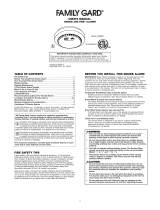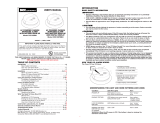
ABOUT SMOKE ALARMS
Batter
y (DC) operated Smoke Alarms:
Pr
ovide protection even when
electricity fails, pr
ovided the batteries are fresh and correctly installed. Units
are easy to install, and do not require professional installation.
AC power
ed Smoke Alarms:
Can be inter
connected so if one unit senses
smoke, all units alarm. They do not operate if electricity fails.
AC with battery (DC) back-up: will operate if electricity fails, provided the
batteries ar
e fresh and correctly installed. AC and AC/DC units must be
installed by a qualified electrician.
Smoke/CO Alar
ms for Solar or Wind Energy users and battery backup
power systems: AC powered Smoke/CO Alarms should only be operated
with true or pur
e sine wave inverters. Operating this Alarm with most battery-
power
ed UPS (uninterruptible power supply) products or square wave or
“quasi sine wave” inverters
will damage the Alarm. If you are not sure about
your inverter or UPS type, please consult with the manufactur
er to verify.
Smoke Alar
ms for the hearing impaired:
Special purpose Smoke Alarms
should be installed for the hearing impair
ed. They include a visual alarm and an
audible alarm horn, and meet the requirements of the Americans With Disabilities
Act. Can be inter
connected so if one unit senses smoke, all units alarm.
Smoke alar
ms are not to be used with detector guards
unless the
combination has been evaluated and found suitable for that purpose.
All these Smoke Alarms are designed to provide early warning of fires if
located, installed and cared for as described in the user’s manual, and if
smoke r
eaches the Alarm. If you are unsure which type of Smoke Alarm to
install, refer the National Fire Protection Association (NFPA) Standard 72
(National Fire Alarm Code) and NFPA 101 (Life Safety Code). National Fire
Pr
otection Association, One Batterymarch Park, Quincy, MA 02269-9101.
Local building codes may also require specific units in new construction or
in different areas of the home.
SPECIAL COMPLIANCE CONSIDERATIONS
This unit alone is not a suitable substitute for complete fire detection
systems in places housing many people—like apar
tment buildings,
condominiums, hotels, motels, dormitories, hospitals, long-term health
care facilities, nursing homes, day care facilities, or group homes of any
kind—even if they were once single-family homes. It is not a suitable
substitute for complete fir
e detection systems in warehouses, industrial
facilities, commercial buildings, and special-purpose non-residential
buildings which require special fire detection and alarm systems.
Depending on the building codes in your area, this unit may be used to
provide additional protection in these facilities.
The following information applies to all five types of buildings listed below:
In new construction, most building codes require the use of AC or AC/DC
powered Smoke Alarms only. AC, AC/DC, or DC powered Smoke Alarms can
be used in existing construction as specified by local building codes. Refer to
NFPA 72 (National Fire Alarm Code) and NFPA 101 (Life Safety Code), local
building codes, or consult your Fire Department for detailed fire protection
requirements in buildings not defined as “households.”
1. Single-Family Residence: Single family home, townhouse. It is recom-
mended this unit be installed on every level of the home, in every bedroom,
and in each bedroom hallway.
2. Multi-Family or Mixed Occupant Residence: Apartment building,
condominium. This unit is suitable for use in individual apartments or condos,
pr
ovided a primary fire detection system already exists to meet fire detection
requirements in common areas like lobbies, hallways, or porches. Using this
unit in common areas may not provide sufficient warning to all residents or
meet local fire protection ordinances/regulations.
3. Institutions: Hospitals, day care facilities, long-term health care facilities.
This unit is suitable for use in individual patient sleeping/r
esident r
ooms,
provided a primary fire detection system already exists to meet fire detection
r
equirements in common areas like lobbies, hallways, or porches. Using this
unit in common areas may not provide sufficient warning to all residents or
meet local fire protection ordinances/regulations.
4. Hotels and Motels: Also boar
ding houses and dormitories. This unit is
suitable for use inside individual sleeping/resident rooms, provided a primary
fire detection system already exists to meet fire detection requirements in
common areas like lobbies, hallways, or porches. Using this unit in common
areas may not provide sufficient warning to all residents or meet local fire
pr
otection or
dinances/r
egulations.
5. Warehouses/Commercial Buildings: DO NOT use this Smoke/CO Alarm in
warehouses, industrial or commercial buildings, special-purpose non-residen-
tial buildings, R
Vs, boats, or airplanes. This Smoke/CO Alarm is specifically
designed for residential use, and may not provide adequate protection in
non-residential applications.
For additional coverage, it is recommended that you install a Smoke Alarm in
all r
ooms, halls, storage areas, finished attics, and basements, where tempera-
tur
es normally remain between 40˚ F (4˚ C) and 100˚ F (38˚ C). Make sure no
door or other obstruction could keep smoke from reaching the Smoke Alarms.
More specifically, install Smoke Alarms:
•
On every level of your home, including finished attics and basements.
•
Inside every bedroom, especially if people sleep with the door partly or
completely closed.
• In the hall near every sleeping area. If your home has multiple sleeping
ar
eas, install a unit in each. If a hall is more than 40 feet long (12 meters),
install a unit at each end.
•
At the top of the first-to-second floor stairway, and at the bottom
of the basement stairway.
Specific r
equirements for Smoke Alarm installation vary from state to state
and fr
om region to region. Check with your local Fire Department for current
requirements in your area.
It is recommended AC or AC/DC units be
inter
connected for added protection.
INST
ALLING SMOKE ALARMS IN MOBILE HOMES
For minimum security install one Smoke Alarm as close to each sleeping area as
possible. For more security, put one unit in each room. Many older mobile homes
(especially those built before 1978) have little or no insulation. If your mobile
home is not well insulated, or if you are unsure of the amount of insulation, it is
important to install units on inside walls only. Smoke Alarms should be installed
where temperatures normally remain between 40˚ F (4˚ C) and 100˚ F (38˚ C).
AGENCY PLACEMENT RECOMMENDATIONS
Standards: Underwriters Laboratories Inc. Single and Multiple Station Smoke
Alarms 217.
NFPA 72 (National Fire Code) Chapter 11
“For your information, the National Fire Protection Association's Standard 72,
reads as follows:”
“11.5.1 One- and Two-Family Dwelling Units.”
“11.5.1.1 Smoke Detection. Where required by applicable laws, codes, or
standards for the specified occupancy, approved single- and multiple-station
Smoke Alarms shall be installed as follows: (1) In all sleeping rooms.
Exception: Smoke Alarms shall not be required in sleeping rooms in existing
one- and two-family dwelling units. (2) Outside of each separate sleeping
ar
ea, in immediate vicinity of the sleeping rooms. (3) On each level of the
dwelling unit, including basements. Exception: In existing one- and two family
dwelling units, approved Smoke Alarms powered by batteries are permitted.”
“A.11.8.3 Are More Smoke Alarms Desirable? The required number of
Smoke Alarms might not pr
ovide r
eliable early war
ning protection for those
areas separated by a door from the areas protected by the required Smoke
Alarms. For this r
eason, it is r
ecommended that the householder consider
the use of additional Smoke Alarms for those areas for increased protection.
The additional areas include the basement, bedrooms, dining room, furnace
r
oom, utility r
oom, and hallways not pr
otected by the r
equir
ed Smoke Alarms.
The installation of Smoke Alarms in kitchens, attics (finished or unfinished),
or garages is not normally recommended, as these locations occasionally
experience conditions that can result in improper operation.”
California State Fire Marshal (CSFM)
Early warning detection is best achieved by the installation of fire detection
equipment in all rooms and areas of the household as follows: A Smoke Alarm
installed in each separate sleeping ar
ea (in the vicinity, but outside bedrooms),
and Heat or Smoke Alarms in the living rooms, dining rooms, bedrooms,
kitchens, hallways, finished attics, furnace rooms, closets, utility and storage
r
ooms, basements, and attached garages.
6
GENERAL LIMITATIONS OF SMOKE/CO ALARMS
This Smoke/CO Alarm is intended for r
esidential use. It is not intended for use
in industrial applications where Occupational Safety and Health Administration
(OSHA) requirements for Carbon Monoxide Alarms must be met. The Smoke
Alarm portion of this device is not intended to alert hearing impaired residents.
Special purpose Smoke Alarms should be installed for hearing impaired resi-
dents (CO Alarms are not yet available for the hearing impaired).
Smoke/CO Alar
ms may not waken all individuals.
Practice the escape plan
at least twice a year
, making sur
e that everyone is involved – fr
om kids to
grandparents. Allow children to master fire escape planning and practice
before holding a fire drill at night when they are sleeping. If children or others
do not readily waken to the sound of the Smoke/CO Alarm, or if there are
infants or family members with mobility limitations, make sure that someone
is assigned to assist them in fir
e drill and in the event of an emer
gency
. It is
recommended that you hold a fire drill while family members are sleeping in
order to determine their response to the sound of the Smoke/CO Alarm while
sleeping and to determine whether they may need assistance in the event of
an emer
gency.
Continued...









